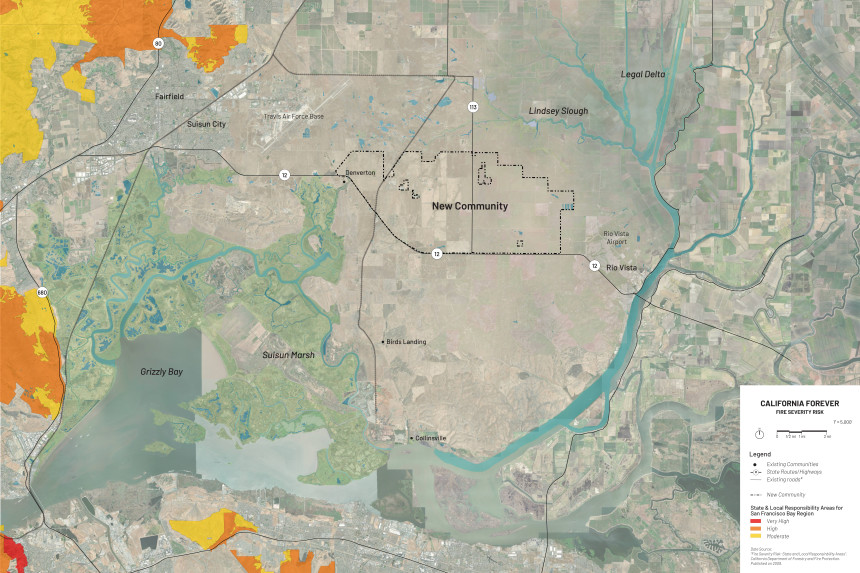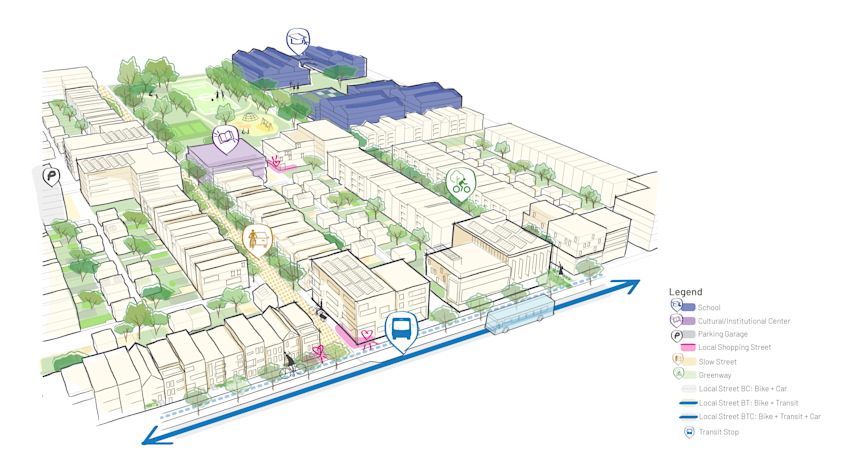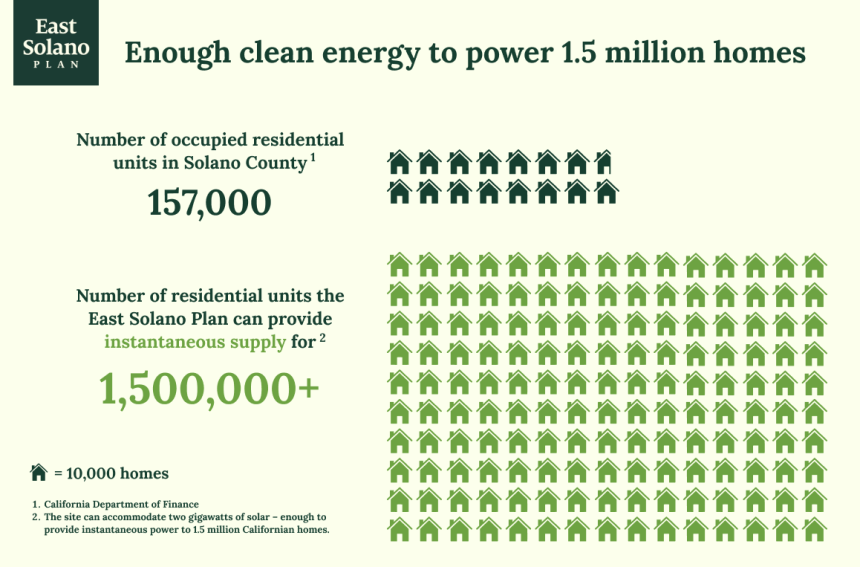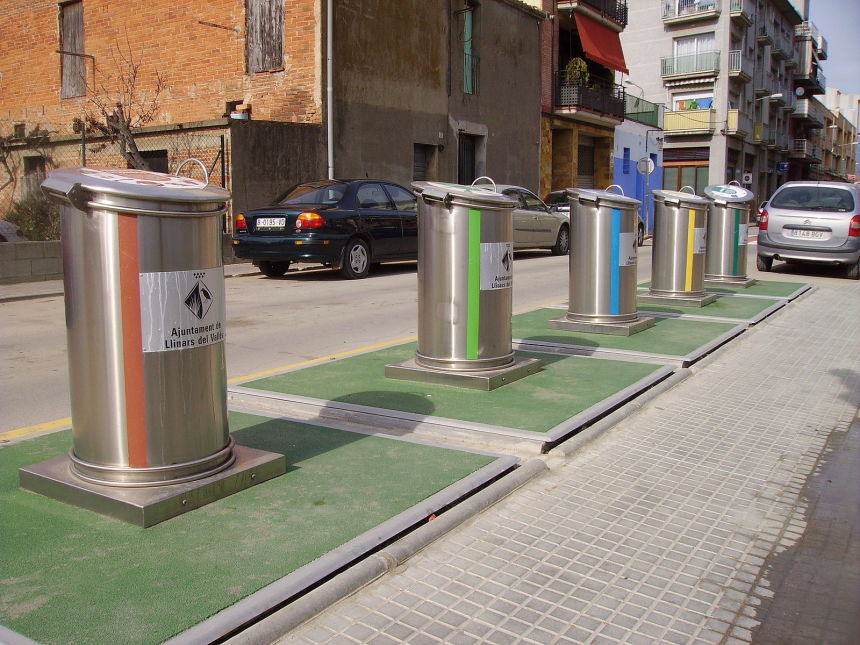The East Solano Plan proposes a compact, walkable community powered by renewable energy. Planned to maximize livability and minimize impact, the community is designed to be the most sustainable of its scale in America—with the potential to have the lowest per-capita carbon emissions of any developed place.
Today, too many urban spaces remain no- or low-walking ones, and demand for walkable places far outstrips supply. That is because walkable cities are easier and more attractive to live in, making for happier, healthier citizens. Health, prosperity, and sustainability go hand in hand.
– Project Drawdown, a leading source for climate solutions
Choosing a resilient site
By design, the East Solano Plan will offer a climate refuge. Its location is ideal from the perspective of climate resiliency — out of the path of sea level rise, flooding, forest fires, and major seismic risks such as faulting and liquefaction.
Sea level rise
The new community is entirely out of the way of sea level rise projected through the year 2150 in the state’s moderately aggressive scenario. The only exceptions are open spaces along the northeastern edge of the new community – but even those, the plan will elevate above 2150 levels by raising the grade before construction.

Fires
Unlike other parts of the region and the western side of Solano County, southeastern Solano County is not in a� high or very high fire hazard severity zone.
The site’s low vegetation means that, while grass fires may occur, forest fires are unlikely. It also means building the new community does not exacerbate high-intensity forest land wildfire ignition risks by creating new wildland-urban interfaces (WUI) affecting forested areas.
In addition, the new community will be built to the most protective and latest building code standards, including fire safety requirements for structures and for planned communities. A recent study of California’s most destructive fires showed that over 98.5% of burned or damaged homes were built prior to the adoption of current building code standards. According to the state’s former fire marshal, fire risks for master- planned communities are very low, and none have suffered any significant loss since existing fire safety standards were adopted.
The East Solano Plan will be fire-hardened, with homes built of ignition-resistant materials, good fire access, and evacuation routes, good water supply, residential fire sprinklers, undergrounded utilities, strong defensible space, green belting with slope and ridge reductions to minimize fire spread, landscaping and fire-resistant plant species restrictions, and regular maintenance for all the fire safety provisions. The plan will also add new fire stations, fire equipment, and more firefighters to provide for more rapid initial fire response in areas where no such services presently exist.
Finally, our leases currently require our local tenants to maintain fire breaks, and we will continue this practice going forward for areas outside of the new community.

Flooding
The site is not within a projected flood hazard zone even if severe rainfall from a one-in-100-year weather event should occur. The project will use state-of-the-art flood management approaches to control potential risks along drainages within the site.
Compact growth = lower environmental impact
The East Solano Plan puts every resident within walking distance of a great local shopping street, parks, and schools. This design for proximity makes it easy to socialize, learn, work, and play minutes from home, reducing the need for long commutes. It leverages a grid that prioritizes active and shared mobility.

Homes and amenities will be in close proximity, and every resident will live ten minutes walking (or closer) to a quality public transit route. This compact design means less open land needs to be developed than otherwise would be with conventional car-dependent subdivisions.
Enabling public transit, biking, and walking
The community will have a minimum of 20 dwelling units per acre (a density similar to San Francisco). Density is fundamental to the project’s sustainability; it minimizes the environmental footprint of the land, so that residents will generate what we expect to be the lowest per capita greenhouse emissions in California, and certainly less than those living in other states.
The design will also achieve far higher rates of walking, biking, and public transit use than most places where we are building (mostly car-dependent subdivisions) in the US, by making them the quickest, cheapest, and most convenient transportation options. This maximizes grid efficiency and gets residents where they need without compromising safety, health, or livability.
As part of California’s required environmental review process, we will conduct a rigorous, peer-reviewed assessment of the projected rates of driving per person. We believe that it will show that building this community leads to lower environmental impact than not building it.
Investing in clean energy
The renewable power generated under the East Solano Plan goes way beyond the needs of the new community. Solar farms will generate up to two gigawatts of energy, which is enough to provide instantaneous power to 1.5 million homes. These renewable projects will improve reliability for not just the new community or even Solano County, but the entire region.

Battery storage balances energy use – during low demand periods, clean energy can be stored for later use, when demands peaks or the sun isn’t shining. Batteries can also offer backup power during outages, increasing reliability.
The East Solano Plan will also use a clean thermal energy grid to reduce fossil fuel reliance and elevate efficiency. District thermal energy systems can distribute thermal energy to buildings from centralized or distributed sources, providing space heating, cooling, and domestic hot water heating. We will use little if any natural gas, which is unprecedented for US residential and commercial developments of this scale.
This enables affordable electrification by allowing the new community to tap into new renewable resources at scale. For example, with geoexchange, we can use the earth as a thermal battery to store heat, extracting the heat when needed using underground pipes connected to buildings and a heat exchanger, providing a more effective way to leverage renewable energy. One source of heat will be waste heat – from data centers, for example.
District thermal systems hold great potential to efficiently and cost-effectively integrate low-carbon energy sources, according to the International Energy Agency. We will also construct highly efficient buildings and energy systems to achieve low per-capita energy use, which will help keep energy bills low.
Incorporating circular economy
Building a new community presents a unique opportunity to create efficient, self-sustaining systems that reuse spent resources from one process to become beneficial inputs into another process.
California Forever is evaluating pneumatic tube systems that transport trash to central collection points using air pressure for seamless, low-carbon waste disposal. Pneumatic disposal reduces the need for garbage trucks, as well as the traffic congestion, noise, and emissions associated with them. Enclosed underground pipes transport waste directly from buildings and collection hubs, minimizing risk of the spills, pests, or smells that can otherwise make streets unhygienic and elevating the appeal of serviced neighborhoods.

Pneumatic waste systems also improve recycling rates and sorting accuracy. Chutes collect trash by waste type at point-of-disposal, and a centralized sorting facility uses advanced sorting technologies to separate recyclables. Separated organics can undergo anaerobic digestion, or a similar renewable fuel generation process, to heat the central thermal systems servicing buildings. This system has been implemented in cities like Barcelona and Stockholm, and is globally lauded for minimizing the amount of waste sent to landfills and creating a new source of clean energy.
The new community will also build efficient water recycling systems. This enables the reuse of appropriately treated residential wastewater for non-potable uses, like irrigation of landscaping, certain industrial uses, and irrigation of nearby agricultural properties. By shifting agricultural lands to use recycled water, the clean surface water resources attached to those parcels can serve residential uses while sustaining irrigated agriculture. Recycling essentially creates a new, sustainable, and highly reliable source of water that grows with your community.
By investing in circular systems that repurpose spent resources for beneficial uses, the East Solano Plan can minimize environmental impact and serve as a global model for self-sustaining communities.
Bringing nature into the city
The East Solano Plan incorporates pocket parks, plazas, large city parks, community gardens, trails, and open space preserves as an integral part of the community. The plan requires ten or more acres of open space per 1,000 people – more than any city in Solano County. San Francisco, whose 1,017-acre Golden Gate Park spans an area greater than New York’s Central Park, offers less than that, even if you include the city’s private golf courses in the equation.
This provides habitat value, improves local climate, and reduces pollution. In addition, the new community will deploy green infrastructure for stormwater management, which improves water quality, reduces impacts of downstream flows, and promotes replenishment of groundwater supplies.

Conclusion
For everyone who cares about the environment, the East Solan Plan shows the way forward for how to accommodate human populations in a way that is sustainable. The plan’s compact growth clusters development to enable walkability and make efficient use of the land. The plan’s excellent public transit and biking will minimize car trips. The new community will be 100% powered by renewable energy. Infrastructure systems will recycle water, heat, and organics – turning waste into resources. The East Solano Plan will have the lowest per-capita greenhouse gas emissions in the United States.
And finally, it will be a refuge from the impacts of climate change, providing a place for hundreds of thousands of people to live safe from forest fires and sea level rise.
All human settlements have impacts. But compared to any other place we can imagine people living, this is a model for how people can live sustainably on the earth.